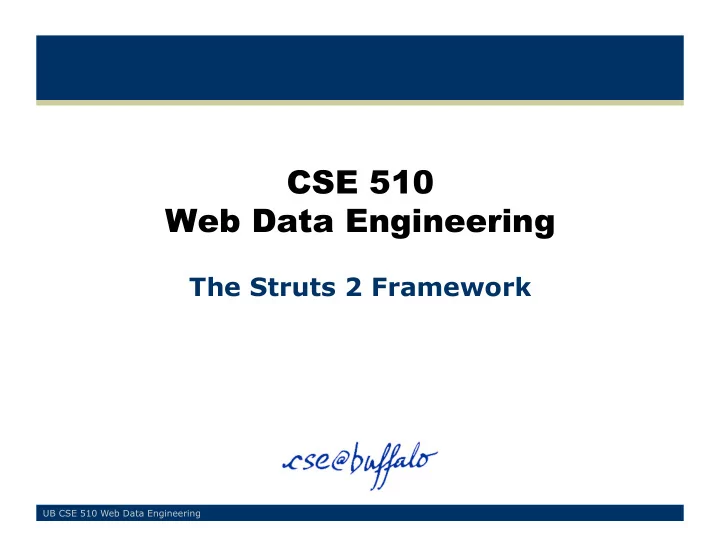

CSE 510 Web Data Engineering The Struts 2 Framework UB CSE 510 Web Data Engineering
What’s The Difference? • A new framework that implements the MVC – It is said to be simpler for development Features: • Action : implements an Action interface along with other interfaces, or extends the ActionSupport class • Validation : through XWork validation framework • Action Execution : different lifecycles 2 UB CSE 510 Web Data Engineering
Auct uction ion MVC Wor Workf kflow low – – Strut uts 1 Start ¡ welcome ¡ Welcome.do ¡ success ¡ forward ¡ Place ¡Bid ¡ Buy ¡ (bu?on) ¡ (bu?on) ¡ highestBid ¡ PageA1.jsp ¡ PageB.jsp ¡ CheckBid1.do ¡ ccForm ¡ Buy.do ¡ bidForm1 ¡ notHighestBid ¡ !validate ¡ failure ¡ highestBid ¡ PageA2.jsp ¡ Place ¡Bid ¡ !validate ¡ (bu?on) ¡ notHighestBid ¡ bidForm2 ¡ CheckBid2.do ¡ 3 UB CSE 510 Web Data Engineering
Auct uction ion MVC Wor Workf kflow low – – Strut uts 2 Start ¡ show.acGon ¡ success ¡ result ¡ Place ¡Bid ¡ Buy ¡ (bu?on) ¡ (bu?on) ¡ highestBid ¡ PageA1.jsp ¡ PageB.jsp ¡ checkBid.acGon ¡ buy.acGon ¡ input ¡ error ¡ Place ¡Bid ¡ error ¡ notHighestBid ¡ (bu?on) ¡ PageA2.jsp ¡ 4 UB CSE 510 Web Data Engineering
How To Migrate From Struts 1 Deploy StrutsPrepareAndExecuteFilter web.xml <filter> <filter-name>struts2</filter-name> <filter-class> org.apache.struts2.dispatcher.ng.filter.StrutsPrepareAndExecuteFilter </filter-class> </filter> <filter-mapping> <filter-name>struts2</filter-name> <url-pattern>/*</url-pattern> </filter-mapping> 5 UB CSE 510 Web Data Engineering
How To Migrate From Struts 1 (cont’d) Deploy StrutsPrepareAndExecuteFilter • A filter is a lightweight servlet that doesn't generate a response, instead it executes in addition to the normal request handling process • Struts2 filter does not have a parameter that defines the names of the configuration files • The default configuration file for Struts2 is struts.xml and needs to be on the classpath of the web application 6 UB CSE 510 Web Data Engineering
How To Migrate From Struts 1 (cont’d) • Rewrite the workflow configuration file – The logic itself is very similar to Struts 1 struts.xml <action name="buy" class="app.actions.Buy"> <result name="success">/pages/PageA1.jsp</result> <result name="error">/pages/PageB.jsp</result> </action> • By default, the extension is .action instead of .do – Defined in the default.properties file (within the Struts2 JAR file) as the struts.action.extension property 7 UB CSE 510 Web Data Engineering
How To Migrate From Struts 1 (cont’d) • Rewrite the workflow configuration file – The logic itself is very similar to Struts 1 struts.xml <action name="checkBid" class="app.actions.CheckBid"> <result name="input">/pages/PageA1.jsp</result> <result name="error">/pages/PageA1.jsp</result> <result name="highestBid">/pages/PageB.jsp</result> <result name="notHighestBid">/pages/PageA2.jsp</result> </action> 8 UB CSE 510 Web Data Engineering
How To Migrate From Struts 1 (cont’d) • Rewrite the action – For the Action, there is no ActionForm bound to it anymore – Instead, Action itself contains the form data public class Buy extends ActionSupport { private String cardNum = null; // setter and getter for the variable public String execute() {...} } 9 UB CSE 510 Web Data Engineering
How To Migrate From Struts 1 (cont’d) • Rewrite JSP pages – Struts 2 uses new taglibs – Provides better support for client-side programming (Ajax, JavaScript) – Conceptually, they are the same as Struts 1 <%@ taglib prefix="s" uri="/struts-tags"%> <s:form action="checkBid" method="POST"> <s:actionerror /> <s:textfield name="itemID" label="Item ID"/> <s:textfield name="bidPrice" label="Bid"/> <s:submit value="Place Bid" align="center"/> </s:form> 10 UB CSE 510 Web Data Engineering
Form Validation • Static validation – Write the configuration in a XML file CheckBid-validation.xml <validators> <field name="itemID"> <field-validator type="requiredstring"> <param name="trim">true</param> <message>Item ID is required</message> </field-validator> </field> </validators> 11 UB CSE 510 Web Data Engineering
Form Validation (cont’d) • Dynamic Validation – Action implements Validateable interface public class Buy extends ActionSupport implements Validateable { ... public void validate() { if (...) { addActionError("..."); } } } 12 UB CSE 510 Web Data Engineering
Objects In Session/Request Scope • In many cases, you need to access objects across pages – Example: Pre-populate form with values • Trivial in Struts 1, as you can save a FormBean in session or request • In Struts 2, there is no FormBean concept • Solution: Action implements the ModelDriven interface, and overrides the getModel() method • When a form that is bound to the action is rendered, getModel() will be called automatically to obtain the bean object 13 UB CSE 510 Web Data Engineering
Objects In Session/Request Scope (cont’d) public class MyAction implements ModelDriven , ServletRequestAware { private HttpSession session; private HttpServletRequest request; private FormBean bean ; // objects defined by me public void setServletRequest(HttpServletRequest request) { this.request = request; this.session = this.getSession(); } public FormBean getModel() { bean = (FormBean) session.getAttribute(FormBean.NAME); if (bean == null) { bean = new FormBean(); bean.setAttribute(FormBean.NAME, bean); } return bean; } public static class FormBean { // setter getter } } 14 UB CSE 510 Web Data Engineering
Recommend
More recommend